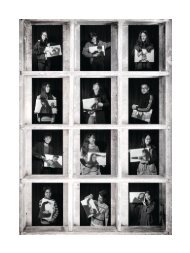ARTBEAT Issue 01 October 2016
The Arts magazine of Alcanta International College, Guangzhou. An international IB secondary school offering Visual Arts Diploma and Theatre Arts Diploma courses. 'ARTBEAT' is created and edited by Head of Arts Jamie Lowe and Drama Teacher John Knauss.
The Arts magazine of Alcanta International College, Guangzhou. An international IB secondary school offering Visual Arts Diploma and Theatre Arts Diploma courses. 'ARTBEAT' is created and edited by Head of Arts Jamie Lowe and Drama Teacher John Knauss.
You also want an ePaper? Increase the reach of your titles
YUMPU automatically turns print PDFs into web optimized ePapers that Google loves.
<strong>ARTBEAT</strong> MAGAZINE<br />
7<br />
Continued from Page 5 : How Dia de los Muertos Came to AIC<br />
Dia de los Muertos - The Day of the<br />
Dead, is a lively Mexican holiday<br />
which honors the dead and is<br />
celebrated throughout Mexico on 1<br />
November. It features in other Latin<br />
American countries too but it is<br />
particularly relevant to Mexico.<br />
The Day of the Dead Festival mixes<br />
Aztec ritual with Catholicism, brought<br />
to the region by Spanish<br />
conquistadores. (Dia de los Muertos is<br />
celebrated on All Saints Day and All<br />
Souls Day, minor holidays in the<br />
Catholic calendar.)<br />
What we know of as<br />
“Halloween” (celebrated the night of<br />
31st <strong>October</strong>) is an equivalent festival,<br />
now observed worldwide but originally<br />
important in North America and<br />
throughout Europe. Halloween has a<br />
similar link to ancient pagan rituals<br />
and beliefs with the attempt for it to<br />
be also “Christianised" by a church<br />
holiday: All Hallows Eve.<br />
The Dia de los Muertos celebration<br />
features in the memorable opening<br />
scenes of the 2<strong>01</strong>5 James Bond film:<br />
“Spectre”. These scenes depict street<br />
parties and parades in Mexico City<br />
with people dressed as skeletons, and<br />
wearing elaborate, highly decorated<br />
colorful costumes, face paints, masks<br />
and flowers. There is a carnival<br />
atmosphere with live music and<br />
processions and it is hard to imagine<br />
that this event has anything to do with<br />
death.<br />
Assured that the dead would be<br />
insulted by mourning or sadness, Dia<br />
de los Muertos celebrates the lives of<br />
the deceased with food, drink, parties,<br />
and activities the dead enjoyed in life.<br />
Dia de los Muertos recognizes death as<br />
a natural part of the human<br />
experience, a continuum with birth,<br />
childhood, and growing up to become<br />
a contributing member of the<br />
community. On Dia de los Muertos,<br />
the dead are also a part of the<br />
community, awakened from their<br />
eternal sleep to share celebrations.<br />
People go to the gravesides of their<br />
passed loved ones to enjoy a family<br />
picnic with homemade treats and chat<br />
by candlelight at night time.<br />
The most familiar symbol of Dia de los<br />
Muertos may be the calacas and<br />
calaveras (skeletons and skulls), which<br />
appear everywhere during the holiday:<br />
in candied sweets, as parade masks, as<br />
dolls. Calacas and calaveras are almost<br />
always portrayed as enjoying life, often<br />
in fancy clothes and entertaining<br />
Can you hear the Floral Skull cursing? Some say that they can!<br />
(especially as we draw closer to Dia de los Muertos).<br />
If you can hear it, then send us what you have heard the skull saying.<br />
The best entries will be published in future issues of Artbeat. For<br />
goodness sake, whatever you do, do not touch its flowers!<br />
E-mail your entries, labelled : Toucha Ma Flowers I Smasha Ya Face to : jlowe@aicib.org








